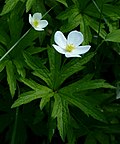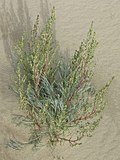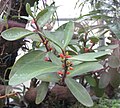Hibbertia caudice is a species of flowering plant in the family Dilleniaceae and is endemic to northern Australia. It is a shrub with wiry stems, hairy...
4 KB (466 words) - 22:53, 28 April 2021
fibrous root systems. Some species have underground stems in the form of caudices or rhizomes. These can be fleshy or woody depending on the species. The...
59 KB (4,845 words) - 06:45, 4 July 2024
The caudex of Dioscorea elephantipes grows largely above the soil surface. Many species that form caudices grow them underground....
343 KB (28,974 words) - 04:35, 13 August 2024
tuber, as in Cyclamen Some of the above, particularly pseudobulbs and caudices, may occur wholly or partially above ground. Intermediates and combinations...
8 KB (947 words) - 08:02, 25 May 2024
Adeniums are appreciated for their colorful flowers and unusual thick caudices. They can be grown for many years in a pot and are commonly used for bonsai...
5 KB (424 words) - 13:53, 18 January 2024
meter (3 ft 3 in) in height. It has fibrous roots and rhizomes or woody caudices. The rough-haired, glandular leaves are up to 40 cm (16 in) long and are...
3 KB (322 words) - 04:30, 7 May 2024
family Ranunculaceae. Individuals are 10–60 cm (3.9–23.6 in) tall, from caudices, with three to six leaves at the base of the plant that are 3-foliolate...
5 KB (536 words) - 00:38, 26 March 2024
parts of the world. Solidago species are perennials growing from woody caudices or rhizomes. Their stems range from decumbent (crawling) to ascending or...
46 KB (4,542 words) - 08:57, 30 July 2024
leaves on 8–22 cm (3+1⁄4–8+3⁄4 inches) petioles. They grow from ascending caudices on long, thin rhizomes. The shoots are 20–80 cm (8–31 inches) tall, and...
6 KB (544 words) - 13:44, 28 March 2024
is native to Asia and Australia. These are perennial herbs with large caudices and toothed ray florets. Species Glossocardia alorensis Veldkamp & Kreffer...
3 KB (157 words) - 00:54, 6 December 2022
perennial herb growing from narrow, woody taproot connected to one or more caudices. It produces a basal rosette of many fleshy flat to cylindrical blunt-tipped...
2 KB (170 words) - 15:28, 8 January 2024
glands on tiny stalks called "stipitate glands". The roots either come from caudices or short rhizomes and are thick, appearing woody, sometimes with cormoid...
56 KB (4,427 words) - 21:33, 24 October 2023
Vegetative: Stems are sometimes succulent, as may also be the underground caudices (rootstock), and may form rhizomes or corms. Bulbils may form along the...
64 KB (6,157 words) - 18:52, 7 August 2024
plants directly from the wild, owing to the aesthetic quality of their long caudices and weathered leaves. The candleholder dudleya (Dudleya candelabrum), native...
47 KB (4,848 words) - 22:28, 30 July 2024
Island and San Nicolas Island, southern California, where it grows on the caudices (the thickened, woody, and persistent base) of Coreopsis gigantea. Its...
3 KB (297 words) - 01:40, 19 May 2024
which are otherwise known as caudices. As the plants are generally rooted in vertical bluffs and cliffs, the caudices in age become decumbent or pendent...
35 KB (3,923 words) - 20:19, 6 May 2024
lateriflorum have short and woody branched caudices, and can have short rhizomes that may produce offsets. The images of caudices are from dried specimens of S. lateriflorum...
160 KB (12,449 words) - 07:37, 11 February 2024
G.L.Nesom, which is cespitose, remaining in a clump, and has corm-like caudices. F1 hybridization with Symphyotrichum novae-angliae can occur where the...
21 KB (1,274 words) - 00:36, 10 January 2024
account of its bright color. In Latin: Fungus pulverulentus virginianus caudice coralline topiario opere contorto "Names Record: Calostoma cinnabarinum"...
45 KB (4,355 words) - 17:17, 10 May 2024
Perennials, (6–)8–20(–40) cm (caespitose), mildly aromatic; taprooted, caudices branched. Stems (1–)2–5, gray-green, tomentose. Leaves persistent, basal...
7 KB (323 words) - 00:59, 16 June 2024
rough patches. There has not been much research done specifically about caudices and how they absorb the nutrients from the ant deposits. Additionally,...
11 KB (1,431 words) - 11:00, 14 August 2024
high-quality habitats. The roots of S. pilosum have bulky and branched caudices that sometimes have long rhizomes which store nutrients for the next year's...
48 KB (4,007 words) - 07:22, 23 June 2024
aptly-named Dudleya viscida. In comparison, anomala has smaller leaves, thinner caudices, and smaller, simpler inflorescences. Anstruther Davidson first described...
8 KB (1,051 words) - 21:51, 9 April 2023
can be up to 7 decimeters (dm) wide, with 10 to 50 clusters of rosettes. Caudices are 4 dm or more long, decumbent in age, and 2 to 5 centimeters thick....
27 KB (2,946 words) - 18:29, 15 January 2024
recognized: S. falcatum var. falcatum, cespitose with up to ten stems from caudices, and known commonly as white prairie aster, western heath aster, creeping...
16 KB (1,166 words) - 07:46, 18 February 2024
drought-tolerant, with a slow-growing habit. It has tuberous roots called caudices. The caudex can grow to 1m in diameter, with clumps of green-blue, coarse...
3 KB (371 words) - 12:10, 12 July 2024
centimeters (40 inches) tall. They are produced from a woody underground caudice or short rhizome. The top of the stems, where the branching begins to the...
6 KB (469 words) - 17:32, 18 March 2024
(12–35 inches) (rarely to 100 cm (39 in)). It can grow in clumps with woody caudices or form colonies if its root system has developed long rhizomes. There...
21 KB (1,593 words) - 17:25, 17 August 2023
commonly as balsamroots. These are perennials with fleshy taproots and caudices bearing erect stems and large, basal leaves. Atop the tall stems are showy...
6 KB (631 words) - 23:27, 29 May 2022


























